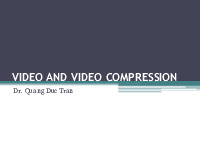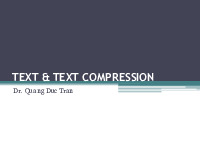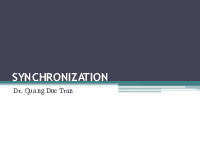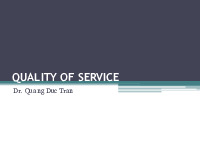



















Preview text:
MULTIMEDIA NETWORKING SYSTEM Dr. Quang Duc Tran
A Simple Data Communication Model Transmission Source Transmitter Receiver Destination System
• Source generates the data to be transmitted
• Transmitter transforms and encodes the information to
produce electromagnetic signals that can be transmitted
across some sort of transmission system.
• Transmission system can be transmission line or a complex
network connecting source and destination
• Receiver accepts the signals and convert them into a form that
can be handled by the destination device.
• Destination takes the incoming data from the receiver. Communication Tasks
Transmission system utilization Flow control Interfacing Addressing Signal generation Routing Synchronization Recovery Exchange management Security
Error detection and correction Network management User Requirements
• Fast preparation and presentation of the different
multimedia types of interest, taking into account the
capabilities of available terminals and services.
• Dynamic control of multimedia applications with respect
to connection interactions and quality on demand,
combined with user-friendly interfaces.
• Intelligent support of users, taking into consideration their individual capabilities. Network Requirements
• High speed and changing bandwidth
▫ Multimedia applications, particularly those using video and
images demand large bandwidth. However, bandwidth for
the foreseeable future will be limited. The limitation arise
from the cost of installing optical fiber transmission,
terminal equipment complexity and speed, etc. • Quality of Services
▫ The availability of multimedia sources places demands on
the service that a network must provide. The most
importance of these is the bit error rate, the packet or cell
loss, delay and delay variation.
Network Requirements (Cont.)
• Synchronization of different information types ▫ Multimedia synchronization refers to temporal
relationships between the media objects. A common
example of temporal relationship is movie or television,
where both audio and video objects are involved.
• Reliable security features and firewalls
▫ Security features include digital watermarking, data hiding,
multimedia content protection, biometrics, multimedia human-computer interface.
▫ Firewall refers to a system, which controls the incoming
and outgoing network traffic based on an applied rule set. MULTIMEDIA NETWORKS Dr. Quang Duc Tran Multimedia Networks • Wide-Area Network (WAN)
▫ Typically, a WAN consists of a number of interconnected
switching nodes. It covers a broad area using leased
telecommunication lines. Conventionally, WANs have been
implemented using one of two technologies, i.e., circuit
switching and packet switching. • Local Area Network (LAN)
▫ A LAN interconnects computers within a limited area.
Hence, the scope of LAN is typically a single building or a
cluster of buildings. The internal data rates of LANs are
much greater than those of WANs. LAN Technology Features FDDI Ethernet Token Ring Transmission rate 125 MBAUD 20 MBAUD 8 & 32 MBAUD Data rate 100 Mbps 10 Mbps 4 & 16 Mbps 4B/5B Manchester Diff. Manchester Signal encoding 80% Efficient 50% Efficient 50% Efficient 100 km 2.5 km Configuration Maximum coverage (UTP, Fiber) (Coax., UTP, Fiber) dependent Maximum nodes 500 1024 250 Maximum distance 2 km (MMF) 300 m 2.5 km between nodes 40 km (SMF) recommended 100 m
FDDI: Fiber Distributed Data Interface FDDI Properties
• FDDI uses a ring topology of multimode or single mode
optical fiber transmission links operating at 100 Mbps to span
up to 200 km and permits up to 500 stations.
• To accommodate a mixture of stream, FDDI is designed to handle two types of traffic: ▫ Synchronous frames that typically have tighter
delay requirements (e.g., voice and video).
▫ Asynchronous frames that have greater delay tolerances (e.g., data traffic).
• FDDI uses TTRT (Target Token Rotation Time) to ensure that
token rotation time is less than some value. FDDI Layers Logical Link Control (LLC) Data Link Layer Media Access Control (MAC) Station Management (SMT) Physical (PHY) Physical Layer
Physical medium dependent (PMD) FDDI Layers
• Physical Layer provides the media independent functions
associated with the OSI physical layer. Its functionalities also
include decoding and encoding (PMD to a symbol stream and
data and control symbols to PMD).
• MAC layer provides fair (i.e., no node has higher priority than
others in accessing the medium) and deterministic access
(i.e., under error-free conditions, the time a node has to wait
to access the medium can be predicted)
• SMT is a sophisticated, built-in network monitoring and
management capabilities. It is not an OSI-RM specification. FDDI Advantages • High Bandwidth (100 Mbps)
• Large distance between FDDI nodes because of very low
attenuation (≤0.3 dB/km) in fibers.
• Improved Signal-to-Noise ratio because of no interference
from external ratio frequencies and electromagnetic noise
• Bit error rate (10-11) is substantially better than that in
Copper (10-5) and microwave system (10-7).
• Very difficult to tap signal from a fiber cable. FDDI Limitations
• High cost of optical components required for
transmission/reception of signals (especially for single mode fiber network)
• More complex to implement than existing low speed
LAN technologies such as Ethernet and Fast Ethernet. WAN Technology
• Public Switched Telephone Network (PSTN)
• Integrated Service Digital Network (ISDN) • Broadband ISDN
• Wireless Network (note: wireless LAN)
• Broadcast Channel: Terrestrial, Cable, Satellite. PSTN
• Now known as Plain Old Telephone Service (POTs)
• The term switched means a subscriber can make a call to
any other telephone on the ‘total’ network.
• The copper wire between the home and central office has a
limited bandwidth (56 Kbps). This is still too low for carrying video with pleasing quality.
• Higher data rates, up to 6 Mbps in the downlink direction are
possible with ADSL (Asymmetric Digital Subscriber Loop)
modems. ADSL is one of the main transport media for
streaming MPEG-1, MPEG-2 movies through VOD services. ISDN
• ISDN is the first network using digital transmission. The data
rate can be multiples of basic channels (B channels) of 64
Kbps each, with multiplying factor ranging from 1 to 24.
• The basic subscription of ISDN comes with a 2B+D channel,
where D channel is 16 Kbps and is used for return signaling.
At 128 Kbps, very low quality video can be achieved.
• ISDN connection is very reliable. H.320 (i.e., the first
recommendation series for audio-video conferencing) was developed for ISDN. Broadband ISDN
• B-ISDN services offer H.0 channels (384 Kbps), H.11 channels
(1.536 Mbps) and H.12 channels (1.920 Mbps). This requires
higher bandwidth coaxial cable or optical fiber.
• B-ISDN uses Asynchronous Transfer Mode (ATM) packet
switching with fixed size packets (known as cells). The very
short cell size (53 Bytes with 48 Bytes payload) makes B-ISDN
suitable for real-time applications with low delay requirements.
• Cell loss can occur due to traffic congestion, although the loss
(10-6-10-4) is quite low for video services.
Why the Cell Size is 53 Bytes?
• The cell size is determined as a trade-off between packetizing
delay and cell overhead. Generally, cell overhead (waste) is
smaller at larger payload sizes.
• However, small cell size is preferred because of cell loss. For
example, a 53 Bytes cell contain 48 voice samples, which is
only 48 x 125 µs = 6 ms of voice. The loss of a cell would be
almost unnoticed. However, a loss of cell with 32 ms of voice would be very disruptive.
• 32 Byte is the maximal payload size, at which there is no
noticeable packetizing delay, but the overhead would be
13.5%. 64 Bytes payload would produce a small echo in voice
communication, but the overhead would be 7.1%. ATM Service Categories • Constant Bit Rate (CBR)
▫ CBR supports real-time applications that require tightly
constrained delay and delay variation (e.g., video
conferencing, telephone call, video/audio distribution). • Variable Bit Rate (VBR)
▫ Real-time VBR supports real-time applications, but may
allow more efficient use of a network.
▫ Non Real-time VBR supports real-time applications, which
are more tolerant of network delays (e.g., airline
reservations, banking transactions, process monitoring)



